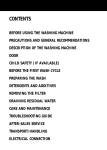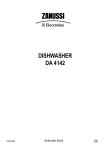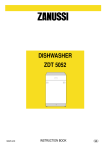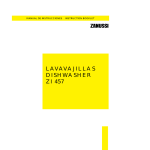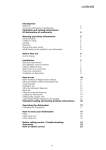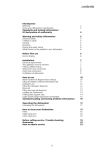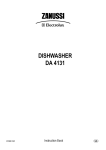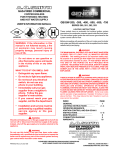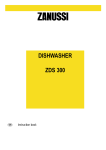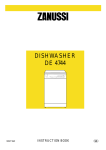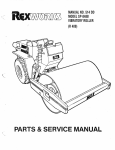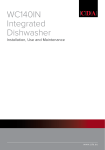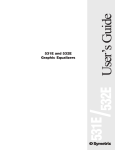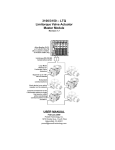Download Zanussi ZT 415 Instruction Booklet
Transcript
INSTRUCTION BOOKLET DISHWASHER ZT 415 CONTENTS Warnings . . . . . . . . . . . . . . . . . . . . . . . . . . . . . . . . . . . . . . . . . . . . . . . . . . . . . . . . . . . . . . . . . . . . . . .page 3 Installation . . . . . . . . . . . . . . . . . . . . . . . . . . . . . . . . . . . . . . . . . . . . . . . . . . . . . . . . . . . . . . . . . . . . . .page 4 Positioning, levelling, water supply connections, water outlet connection . . . . . . . . . . . . . . . . . . . . . . . .page 4 The electrical connections . . . . . . . . . . . . . . . . . . . . . . . . . . . . . . . . . . . . . . . . . . . . . . . . . . . . . . . . . . . .page 5 Use . . . . . . . . . . . . . . . . . . . . . . . . . . . . . . . . . . . . . . . . . . . . . . . . . . . . . . . . . . . . . . . . . . . . . . . . . . . . .page 6 Control panel . . . . . . . . . . . . . . . . . . . . . . . . . . . . . . . . . . . . . . . . . . . . . . . . . . . . . . . . . . . . . . . . . . . . . .page 6 The water softener, filling with salt . . . . . . . . . . . . . . . . . . . . . . . . . . . . . . . . . . . . . . . . . . . . . . . . . . . . . .page 7 Use of rinse aid, use of detergent . . . . . . . . . . . . . . . . . . . . . . . . . . . . . . . . . . . . . . . . . . . . . . . . . . . . . . .page 8 Loading the machine, use of the lower basket, use of the upper basket . . . . . . . . . . . . . . . . . . . . . . . . .page 9 Adjusting the height of the upper basket . . . . . . . . . . . . . . . . . . . . . . . . . . . . . . . . . . . . . . . . . . . . . . . . .page 10 Helpful hints . . . . . . . . . . . . . . . . . . . . . . . . . . . . . . . . . . . . . . . . . . . . . . . . . . . . . . . . . . . . . . . . . . . .page 10 Washing programmes . . . . . . . . . . . . . . . . . . . . . . . . . . . . . . . . . . . . . . . . . . . . . . . . . . . . . . . . . . .page 11 Operating sequence . . . . . . . . . . . . . . . . . . . . . . . . . . . . . . . . . . . . . . . . . . . . . . . . . . . . . . . . . . . .page 12 Maintenance and cleaning . . . . . . . . . . . . . . . . . . . . . . . . . . . . . . . . . . . . . . . . . . . . . . . . . . . . . .page 13 Cleaning the central filters, cleaning the large filter, internal and external cleaning . . . . . . . . . . . . . . . . .page 13 Prolonged periods of Non-Operation . . . . . . . . . . . . . . . . . . . . . . . . . . . . . . . . . . . . . . . . . . . . . . . . . . . .page 13 Servicing . . . . . . . . . . . . . . . . . . . . . . . . . . . . . . . . . . . . . . . . . . . . . . . . . . . . . . . . . . . . . . . . . . . . . . .page 14 Building-in . . . . . . . . . . . . . . . . . . . . . . . . . . . . . . . . . . . . . . . . . . . . . . . . . . . . . . . . . . . . . . . . . . . . . .page 16 Peace of mind for twenty four months . . . . . . . . . . . . . . . . . . . . . . . . . . . . . . . . . . . . . . . . . .page 18 TECHNICAL SPECIFICATIONS DIMENSIONS Width Height Max depth Max depth with door open ELECTRICAL CONNECTION Voltage cm 44,6 cm 82 - 88 cm 55,5 cm 115 220-240 V/50Hz POWER OF HEATING ELEMENT 2570 W OVERALL POWER 2770 W WATER SUPPLY PRESSURE minimum maximum 7 psi - 49 KN/cm2 110 psi - 758 KN/cm2 CAPACITY (STANDARD IEC PLACE SETTINGS) CONSUMPTION: 9 Water Electricity 18 lt 1.2 kW/h This appliance complies with the following E.E.C. Directives: - 73/23 of 19.2.73 (Low Voltage Directive) and subsequent modifications; - 89/336 of 3.5.89 (Electromagnetic Compatibility Directive) and subsequent modifications. PID20GB 2 WARNINGS It is most important that this instruction book should be retained with the appliance for future reference. Should the appliance be sold or transferred to another owner, or should you move house and leave the appliance, always ensure that the book is left with the appliance in order that the new owner can get to know the functioning of the appliance and the relevant warnings. These warnings are provided in the interest of safety. You MUST read them carefully before installing or using the appliance. Installation ■ Do not put in your dishwasher; cutlery with wooden or horn handles or glued parts, bronze cutlery, saucepans with wooden handles, unless they are sold as dishwasher proof, aluminium ware, crystal ware, leaded glass, plastic articles unless sold as dishwasher proof, antique china or fine decorated china unless sold as dishwasher proof. Always check with the manufacturer of the item if in any doubt. ■ This appliance is heavy. Care should be taken when moving it. ■ It is dangerous to alter the specifications or attempt to modify this product in any way. ■ Care must be taken to ensure that the appliance does not stand on the electrical supply cable. ■ Any electrical work required to install this appliance should be carried out by a qualified electrician or competent person. ■ A chemical reaction can occur between silver cutlery and stainless steel cutlery. As a precaution, do not wash together. ■ Any plumbing work required to install this appliances should be carried out by a qualified plumber or competent person. ■ Care should be taken when cleaning the bottom door seal and hinge area as any exposed metal edges may cut if care is not taken. ■ Built-in dishwashers only: The appliance must be secured to the underside of the worktop using the brackets provided. Failure to do this could result in an unstable appliance which may cause damage or injury. ■ This product should be serviced by an authorised Zanussi engineer, and only genuine Zanussi spare parts should be used. ■ Under no circumstances should you attempt to repair the machine yourself. Repairs carried out by inexperienced persons may cause injury or serious malfunctioning. Contact your local Zanussi Service Centre. Always insist on genuine Zanussi Spare Parts. Child Safety ■ This appliance is designed to be operated by adults. Children should not be allowed to tamper with the controls or play with the product. Conservation In the interests of the Environment: During Use When disposing of your old appliance: ■ Zanussi dishwashers are designed to be used for washing normal household utensils. Items that are contaminated by petrol, paint, steel or iron debris, corrosive, acidic or alkaline chemicals are not to be washed in a dishwasher. ■ Under no circumstances should you open the door whilst,the appliance is in operation. Always turn off the appliance before opening the door. ■ When finishing loading or unloading close the door, as an open door can be a hazard. ■ Unplug the appliance and turn off the water after use. ■ If your house is fitted with a water softening unit or if you live in a soft water area, it is not necessary to add salt to the water softening unit in the dishwasher. PAV04GB 3 ■ Help to keep your country tidy - use authorised disposal sites for your old appliances. ■ The materials used on this appliance marked with the symbol are recyclable. ■ Check with your local Council or Environmental Health Office to see if there are facilities in your area for re-cycling this appliance. ■ If you are discarding an old appliance that has a lock or catch on the door, you must ensure that it is made unusable to prevent young children being trapped inside. INSTALLATION Remove all packaging before positioning the machine. To make this easier, the hose itself may be turned to the left or the right. In either case, be sure to incorporate the strainer (A) supplied with the machine into the joint. See picture. Positioning If possible, position the machine next to a water tap and a drain. The dishwasher features fill and drain hoses which can be turned either to the left or the right to suit the installation . CA06 Caution: the retaining ring must be correctly fitted to avoid water leaks. Levelling Avoid bends or kinks in the hose which could prevent or slow down the flow of water. Good levelling is essential for correct closure and sealing of the door. If the machine is connected to new pipes or pipes which have not been used for a long time, you are advised to run the water for a few minutes before connecting the inlet hose. This will prevent deposits of sand or rust clogging the inlet hose filter. When the appliance is correctly levelled, the door will not catch on the spacers on either side of the cabinet. Water Outlet Connection The end of the drain hose can be connected as follows: to the sink outlet siphon, securing it if necessary with a clip; IN12 IN11 If the door does not close correctly, loosen or tighten the adjustable support feet, until the machine is perfectly level. to a wall outlet provided with vent-hole, minimum internal diameter 4 cm; The waste connection must be at a height of between 30 cm (minimum) and 100 cm (maximum) from the floor. Water Supply Connections min 4 cm Your local Water Authority will advise you on the average mains pressure in your area. Where the water is supplied via a cold water storage cistern, you can work out the pressure yourself by measuring the vertical distance (or «head») between the machine's inlet hose and the outlet from the cold water storage cistern, allowing roughly 1 psi for every 2 feet. A CA04 + 2 m max min 30 cm max 100 cm Ø 18 Ø 21 Ø Ø The water pressure must be within the limits given in the technical specifications, as it will not function correctly if pressure is outside these specifications. 18 21 This dishwasher must be permanently plumbed into a cold water supply. CS05 It makes no difference which way the drain hose faces, either to the right or left of the dishwasher. Avoid bending or kinking the hose as this could prevent or slow down the discharge of water. For making the connection itself, the coupling nut fitted to the machine's supply hose is designed to screw onto either a 3/4 inch gas thread spout, or to a purpose made quick-coupling tap such as the Press Block. If you use a drain hose extension it must be no longer than 2 metres and its internal diameter must be no smaller than the diameter of the hose provided. Likewise the internal diameter of the couplings used for connection to the waste outlet must be no smaller than the diameter of the drain hose. Note: The sink plug must not be in place when the machine is draining as this could cause the water to siphon back into the machine. PIN07GB 4 A replacement cover/carrier must be obtained from your local Zanussi Service Force Centre whose address is listed in the Customer Care Booklet which accompanies your instruction manual. The electrical connections WARNING: THIS APPLIANCE MUST BE EARTHED. The manufacturer declines any liability should this safety measure not be observed. This appliance complies with the following E.E.C. Directives: - 73/23 of 19.2.73 (Low Voltage Directive) and subsequent modifications; If the plug that is fitted to your appliance is not suitable for your socket outlet, it must be cut off and the appropriate plug fitted. - 89/336 of 3.5.89 (Electromagnetic Compatibility Directive) and subsequent modifications. Remove the fuse from the cut off plug. The cut off plug should then be disposed of to prevent the hazard of shocks in case it should be plugged into a 13 amp socket in another part of your home. Please ensure that when the appliance is installed it is easily accessible for the engineer in the event of a breakdown. Important The wires in the mains lead are coloured in accordance with the following code: Green and Yellow - Earth Blue - Neutral Brown - Live If you fit your own plug, the colours of the wires in the mains lead of your appliance may not correspond with the markings identifying the terminals in your plug, proceed as follows: GREEN & YELLOW 13 AMP 13 AMP FUSE BROWN BLUE CE01 CORD CLAMP Connect the Green and Yellow (earth) wire to the terminal in the plug which is marked with the letter «E» or the earth symbol or coloured green and yellow. Connect the Blue (neutral) wire to the terminal in the plug which is marked with the letter «N» or coloured black. Connect the Brown (live) wire to the terminal in the plug which is marked with the letter «L» or coloured red. The plug moulded onto the lead incorporates a fuse. For replacement, use a 13amp BSI362 fuse. Only ASTA or BSI approved fuses should be used. The plug must not be used if the fuse cover/carrier is lost. The cover/carrier is indicated by the coloured insert at the base of the plug. PIN08GB 5 USE Control panel THE CONTROLS 1. ON/OFF Pushbutton In this fully integrated appliance the controls are located on the top of the door. When selecting a programme, the door needs to be partially opened. Depress this pushbutton to switch the dishwasher on. The ON/OFF indicator light (3) illuminates indicating that the washing programme can be selected and started. Depress again this button to switch the appliance off. Audible signals have been introduced to help indicate which operations the dishwasher is performing. Short «instruction accepted» signal 2. Salt Refill Indicator Light "SALT" When any of the buttons are pressed: a short audible signal informs you that the machine has accepted the instruction given. This light illuminates when the salt container needs refilling. This light will remain on in a soft water area where salt is not required. Long «programme run» signal 3. ON/OFF Indicator Light A continuous audible signal lasting about one second, heard only when you close the dishwasher door, informs you that the washing programme is starting. This illuminates when the ON/OFF button (1 ) is depressed, indicating that the machine is on. Intermittent «end of programme» signal 4. Programme Selector Buttons An intermittent audible signal, lasting in total five seconds, informs you that the wash programme has ended. If you wish to deactivate these audible signals, press both the NORMAL 65°c and ECONOMY 55°c programme buttons together for about 3 seconds, until the intermittent audible signal can no longer be heard. Depress the button corresponding to the desired washing programme (see washing programme chart). 5 End of Cycle Indicator Light This light flashes when the programme has finished. To switch it off depress the ON/OFF pushbutton (1). SO82 To reactivate the audible signals, press both buttons together again for about 3 seconds, until an intermittent audible signal is heard. PPC21GB 6 - Press the programme button corresponding to the required level. The Water Softener Water contains varying amounts of lime and mineral salts depending on the area in which you live: these are deposited on the dishes leaving white marks. - 5 seconds after having last pressed any of the programme buttons, the dishwasher memorises the level selected and returns to the programme setting mode. The higher the content of these salts, the harder your water will be. The «hardness» level is measured on 2 equivalent scales: Clarke degrees or French degrees. Contact your local Water Authority to find the exact water hardness level for your area. Important Salt MUST be used regularly from level 2 upward. If your water is «level 1» it is already soft and therefore there is no need to use salt. The dishwasher is equipped with a softener which uses special dishwasher salt to provide lime-free (softened) water. The softener can treat water hardness up to 90 French degrees via 5 adjustment levels. Filling with Salt Find on the table below the level corresponding to the hardness of your water and the required adjustments: Only use salt designed specifically for use in dishwashers. Other types of salt contain high percentages of other substances which may reduce the efficiency of the softener. Water hardness °dH Clarke degrees °TH French degrees 0-10 11-27 28-35 36-49 50-63 0-14 15-39 40-50 51-70 71-90 Level Use of salt Unscrew the cap of the salt container. 1 *2 3 4 5 Fill the container with 1 litre of water (this operation is necessary only the first time). **NO YES YES YES YES Place approximately 1kg of dishwasher salt inside using the funnel provided (see figure). Replace the cap making sure that there is no trace of salt on the screw thread or on the gasket. * The water softener is factory set at level 2 as this suits most users. ** If you use phosphate free detergents containing enzymes, use salt starting from 6 Clarke degrees (7 French degrees). E L T SA Ltightly. Screw the cap A You may also change the factory setting by means of the wash programme selector buttons. Each button corresponds to a different level: LZ SA L SE S LT SA Level 1 = RINSE AND HOLD Programme Button Level 2 = INTENSIVE 70°c Programme Button Level 3 = NORMAL 65°c Programme Button Level 4 = ECONOMY 55°c Programme Button Level 5 = QUICK 55°c Programme Button SR06 To select a different level, proceed as follows: SR03 - Press the NORMAL 65°c and QUICK 55°c programme buttons simultaneously for about 5 seconds until the short «instruction accepted» signal is heard. The pilot light corresponding to the current level flashes very rapidly. When this has been done, all that is required is to periodically add salt to the container. You are reminded of this by the Salt refill light «SALT» on the control panel which will illuminate when the salt has finished. The salt container always has some water inside which will normally overflow when refilling with salt. Caution Only fill with salt just before starting one of the complete washing programmes (not Rinse and Hold programme). This will prevent any grains of salt or salty water, which may have been spilled, remaining on the bottom of the machine for any period of time. This could cause corrosion. AA02 SO83 PAA12GB 7 To open the dispenser lid, pull the catch (D). This will open it. Rinse Aid The use of this liquid ensures thorough rinsing, spot and streak free drying, making the water run quickly off the dishes for sparkling results. It is automatically added during the hot rinse. The dispenser, which is positioned inside the door, holds about 110 ml of rinse aid, which is sufficient for 16-40 dishwashing programmes, depending upon the dosage setting. D M M IN AX Filling with Rinse Aid To help you to correctly dose the right amount of detergent, inside the container there are two reference marks: - MIN = 15 ml - MAX = 30 ml DE07 Open the container by turning the lid (A) anticlockwise. Add rinse aid until the container is completely full (approx. 110 ml). The indicator (B) will be completely dark. The amount of detergent to be used varies depending on how soiled the dishes are and the type of dishes being washed. We recommend the amounts shown in the programme chart on the next pages. Top up with rinse aid when the indicator (B) becomes clear. After filling the dispenser with detergent, close the lid. Remember to CLOSE the lid after every refill. The programme with prewash requires a small extra amount of detergent of approximately 5g = half dessert spoon to be poured over the lid of the dispenser, as shown on the picture. Caution Clean up any rinse aid spilt during filling with an absorbent cloth to avoid excess foaming during the next wash. Adjusting the Dose According to the finish and drying results obtained, adjust the dose of rinse aid by means of the 6 position selector (C) (position 1 - minimum dose, position 6 maximum dose). (Start from position 3). Gradually increase the dose if there are drops of water or lime spots on the dishes after washing. Reduce it if there are sticky whitish streaks on the dishes. For the intensive programme (suitable for particularly dirty pans and dishes) an extra 10g of detergent must be poured over the dispenser’s lid. At the end of any washing programme the lid is always open, ready for the next wash. 32 Since not all detergents are the same, you should also consult the instructions on the packet. 1 65 DE02 C BR04 Remember that insufficient quantities of detergent will produce poor washing results whereas an excessive amount of detergent does not improve washing results and is also wasteful. 65 4 3 21 B A Using no more than the correct amount of detergent also contributes to reducing pollution. Caution: Do not put liquid detergent into the rinse aid compartment Phosphate free detergents with enzymes Use of Detergent These new compact powders are generally phosphatefree. As phosphates have water softening properties, we suggest you add salt to the salt container even If the hardness of your water is as low as 6 Clarke degrees. This will avoid lime deposits on crockery and the inner tub. Before starting any of the dishwashing programmes, except for the rinse and hold programme, load the detergent in the dispenser. Use only tablets, powder or liquid detergents specifically designed for domestic dishwashers. Unsuitable detergents (such as those for washing by hand) do not contain the right ingredients for machine washing and hamper correct functioning of the machine. Zanussi recommends the use of Finish dishwasher detergent. PBR13GB 8 The two rear rows of prongs on the lower basket can be easily lowered to allow you to load pots, pans and bowls. To lower the prongs: slightly pull them upward and let them drop down (see picture); to bring them back to the standing position, just pull them up again. Loading your Machine Before placing dishes in the machine, remove any scraps of food from the plates (small bones, toothpicks, fish bones, scraps of meat and vegetables, fruit skins etc.) to avoid clogging the filters and consequently reducing performance. Open the door and slide out the baskets to load the dishes. Use of the Lower Basket UI18 The lower basket is designed to take saucepans, lids, plates (up to 27 cm in diameter), salad bowls, cutlery etc. Serving dishes and large lids should be arranged around the edge of the basket, ensuring that the upper spray arm can turn freely. UI23 Use of the Upper Basket The upper basket is designed for plates (dessert plates, saucers, dinner plates up to 24 cm in diameter), salad bowls, cups and glasses; these should be arranged as shown in the pictures. Glasses with long stems can be placed upside-down in the raised cupracks. IEC 436 / DIN 44990 US08 IEC 436 / DIN 44990 UI24 Cutlery should be placed in the removable cutlery basket with the handles facing downwards. If the handles protrude from the bottom of the basket, obstructing the lower spray arm, load the cutlery with the handles facing upward. US07 The cup-rack on the left folds upwards to increase your loading flexibility. Mix spoons with the other cutlery to prevent them sticking together. Teaspoons may be loaded into the special slots provided in the cutlery basket handle. Before closing the door, ensure that the spray arms can rotate freely. UI10 PCE12GB 9 Adjusting the Height of the Upper Basket If washing very large plates (over 27 cm and up to 31 cm in diameter) you can load them in the lower basket after moving the upper basket to the higher position as follows: A Move the front runner stops (A) of the upper basket outward and slide the basket out. Refit the basket in the higher position and replace the stops (A) in their original position. RC01 When the top basket is in the higher position it will only take plates up to 20 cm in diameter and you will not be able to use the raised cup racks. HELPFUL HINTS For Best Washing Results: Items not Suitable for Dishwashers Before loading, remove all scraps of food and soak very heavily soiled pots and pans. Always arrange saucepans, cups and glasses etc. upside-down. Tilt items with convex or concave surfaces so that the water drains off easily. The following should not be washed in the dishwasher: Cutlery or dishes with wooden or horn handles or glued parts. Handmade items, wooden objects, antiques or handpainted china. Certain types of decoration can discolour when washed in a dishwasher. Crystal-ware and plastic objects, if not guaranteed dishwasher-proof, should be washed by hand. You are advised to place them in the upper basket and to select a delicate programme. Certain types of glass can also become opaque after being washed several times in a dishwasher. Silver cutlery tends to go black if mixed with steel cutlery. Place it in the cutlery basket separate from the others. Iron and cast iron objects can rust and stain other items. Aluminium tends to go black; copper, pewter and brass tend to stain. Long items of cutlery such as ladles, carving knives etc. should be positioned horizontally in the upper basket. Avoid contact between the dishes as far as possible; correct arrangement of the items will give better washing results. Light items (plastic bowls etc.) should be loaded in the upper basket and arranged so that they do not move during washing. You will improve drying results by leaving the dishwasher door ajar for at least 15-30 minutes as soon as the programme finishes. Care must be taken when opening the door, as steam will escape. To Save Energy Do not prewash dishes under running water. Caution: You are advised not to load very small items which can fall through the baskets. Place dishes in the machine immediately after every meal and wait until the dishwasher is full before washing. Note: When buying new dishes, ensure that they are dishwasher-proof. If necessary run the Rinse and Hold programme (see Programme Chart on the following pages), so that any food scraps do not become caked on the dishes while you are waiting to run the complete wash programme. Select an ECONOMIC programme when the baskets are not very full and/or when the dishes are not very soiled, following the instructions given in the Programme Chart (ECONOMY programmes, QUICK programme). PCL12GB 10 WASHING PROGRAMMES Recommended quantity of detergent Programme Type of load and degree of soil RINSE & HOLD in the dispenser Required pushbuttons ON OFF RINSE & HOLD — on the dispenser lid — Cycle description Cold rinse to prevent food scraps from drying up and sticking to the dishes INTENSIVE 70°c Heavily soiled crockery, pots, pans and cutlery ON OFF INTENSIVE 70°c 1 heaped dessert spoonful (15 g) 1 level dessert spoonful (10 g) Prewash at 55°C Main wash at 70°C 2 cold rinses 1 hot rinse at 65°C Hot air drying *NORMAL Normally soiled crockery, pots, pans, and cutlery, ON OFF NORMAL 65°c 1 heaped dessert spoonful (15 g) Half dessert spoonful (5 g) Cold prewash Main wash at 65°C 1 cold rinse 1 hot rinse at 65°C Hot air drying ECONOMY 55°c Lightly soiled crockery, pots and cutlery ON OFF ECONOMY 55°c 1 heaped dessert spoonful (15 g) Half dessert spoonful (5 g) Cold prewash Main wash at 55°C 1 cold rinse 1 hot rinse at 65°C Hot air drying **QUICK Lightly soiled crockery ON OFF QUICK 55°c 1 heaped dessert spoonful (15 g) 65°c WASH 55°c — Main wash at 55°C 1 cold rinse 1 hot rinse at 55°C * This programme is equivalent to IEC436 standard. ** This is a special programme to wash in a short time (approx. 40 minutes) a full load of lightly soiled dishes, glasses and crockery (except pots) so that you may re-use them promptly. Due to the shortness of this programme, no drying phase is provided. PTP18GB 11 OPERATING INSTRUCTIONS 1 Check that the filters are clean 7 Start the programme (see cleaning instructions) Open the water supply. Close the dishwasher door. An audible signal of about 1 second advises you that the programme has started. The indicator light which corresponds to the programme under way is now permanently on. 2 Switch on the appliance at the mains supply. Caution 3 Check that there is salt and rinse aid In general it is not advisable to open the door while the machine is working; if the door is opened however, a safety device ensures that the machine stops. 4 Load the dishes If you need to stop the dishwasher at any moment during the wash programme, switch the appliance off at the plug; open the door and press the ON/OFF button. Remove any scraps of food. Pull the lower basket out and arrange the saucepans, plates and cutlery in it. Care must be taken if opening the door, as steam will escape. Pull the upper basket out and arrange the plates, saucers, glasses and cups etc. in it. Slide the baskets back into the machine. 8 At the end of the washing programme Ensure that the spray arms can rotate freely. The dishwasher will automatically stop and an intermittent audible signal of about 5 sec. informs you that the programme has finished. 5 Measure out detergent Wait until the end of the signal before opening the door. Pour the required amount of detergent into the dispenser according to the indications in the Washing Programmes chart and close the lid. Open the door. The End of Cycle indicator light flashes. Depress the ON/OFF button to switch the dishwasher off. 6 Set the programme You are advised to turn off the water tap and switch off the appliance at the plug socket. The selection of a programme occurs with the door partially opened. Wait a few minutes before removing the dishes; in this way they will be cooler and the drying will be improved. Depress ON/OFF button (1); the ON/OFF indicator light (3) comes on. Empty the lower basket first and then the upper one; this will avoid water dripping from the upper basket onto the dishes in the lower one. Depress the programme button which corresponds to the washing programme you wish to select; the corresponding indicator light will flash. 8 Cancel the wash programme To change a wash programme in progress depress the button corresponding to the programme you wish to cancel for about 1 sec., until the relevant control light goes out. The dishwasher is now reset and you can select a new programme. PSO04GB 12 MAINTENANCE AND CLEANING Check that the spray arm nozzles are not obstructed. To remove the bottom spray arm, release it from its securing catches and pull it out. Cleaning the Central Filters (After each wash) Inspect the central filters (B) and (C) and remove any scraps of food with a brush, under running water. Clean the external surfaces of the machine and control panel with a soft damp cloth. If necessary use only neutral detergents. Never use abrasive products, scouring pads or solvents (acetone, trichloroethylene etc...). Filters (B) and (C) are both removed by lifting up the outer one (B) (pulling the central funnel upwards); the smaller filter (C) can then be removed by pressing the two tongues (D). D The upper spray arm The upper spray arm should not be removed for general cleaning, however if a blockage occurs it can be removed for cleaning as follows: C Slide out the upper basket. Push downwards on the water feed pipe, simultaneously push the spray arm upwards and turn it in a clockwise direction. B MA02 MA08 Once cleaned, refit the filters by pressing them down until they click into place. Cleaning the Large Filter MA09 To reassemble the upper spray arm push downwards on the water feed pipe, simultaneously push the spray arm upwards and turn it anticlockwise. (Once a month) Clean the large filter (A) on both sides under running water, using a brush. To take it out, remove the spray arm by pressing the two tongues (E), turn the ring (F) anticlockwise (towards the left) and then slide the whole part out. Refit the filter following the above instructions in reverse order. Prolonged Periods of Non-Operation If you are not using the machine for any period of time you are advised to: unplug the appliance and turn off the water; fill the rinse aid dispenser; E leave the door ajar to prevent the formation of unpleasant smells; A leave the inside of the machine clean. Frost Precautions F Avoid placing the machine in a location where the temperature is below 0°C. MA03 Caution: the dishwasher must not be used without filters. If this is unavoidable, empty the machine, close the water inlet tap, disconnect the water inlet pipe and empty it. Incorrect repositioning of the filters will produce poor washing results. Moving the Machine Cleaning of the filters is vital to ensure correct operation of the machine. If you have to move the machine (you are moving house etc...): Internal and External Cleaning unplug it; You must ensure that the seals around the door, the detergent and rinse aid dispensers are cleaned regu larly with a damp cloth. turn off the water tap; remove the water inlet and discharge hoses; pull the machine out together with the hoses. We recommend you carryout a maintenance wash every 3 months, by running a 65° C wash programme without dishes using detergent. Caution: avoid over tilting the machine during transport. PMA08GB 13 SERVICING Certain problems are often due to lack of simple maintenance or oversights and can be solved easily without having to call out an engineer. If the indicator light of the QUICK programme is flashing If the machine will not start The dishwasher does not empty out water ■ The door has not been properly closed. ■ The plug is not properly inserted in the power socket. ■ There is no current at the socket. Check the fuse. This dishwasher may display a fault code in the pilot lights of the programmes which will assist you in identifying the fault. If the ON/OFF indicator light is illuminated and one of the programme's indicator light is flashing please carry out the following checks. ■ The discharge pipe is bent. Eliminate the bend (see instructions for connection to the drain). Switch off the dishwasher; switch it back on and start the wash programme. If the alarm reappears, call the Service Centre. ■ The sink drain is blocked Unblock the sink drain pipe. Switch off the dishwasher; switch it back on and start the programme. If the alarm reappears, call the Service Centre. ■ The discharge pipe extension is not correct. Carefully follow the instructions for "Connection to the drain”. Switch off the dishwasher; switch it back on and start the wash programme. If the alarm reappears, call the Service Centre. ■ The wall drain connection has no breather. Consult a qualified engineer. If the pilot light of the RINSE & HOLD programme is flashing The dishwasher will not fill with water ■ The water tap is closed. Open the tap. Switch off the dishwasher; switch it back on and start the wash programme. If the alarm reappears, call the Service Centre. ■ Mains water supply cut off Wait for the supply to be restored. Switch off the dishwasher; switch it back on and start the wash programme. If the alarm reappears, call the Service Centre. ■ Water feed pipe bent or squashed Reposition the pipe (see instructions for connection to the water supply). Switch off the dishwasher; switch it back on and start the wash programme. If the alarm reappears, call the Service Centre. ■ Filter in the water feed pipe clogged Close the water tap, unscrew the water feed pipe and thoroughly clean the filter. Screw the pipe back on and open the water tap. Switch off the dishwasher; switch it back on and start the wash programme. If the alarm reappears, call the Service Centre. If the pilot light of the NORMAL OR ECONOMY programme is flashing ■ The dishes are not clean (poor wash) ■ ■ ■ ■ ■ ■ ■ If the indicator light of the INTENSIVE programme is flashing ■ General Switch off the dishwasher; switch it back on and start the wash programme. If the alarm reappears, call the Service Centre. ■ ■ The filters are clogged Clean the filters (see MAINTENANCE section). Check outlet hose is not blocked. Check dishes are correctly loaded. Switch off the dishwasher; switch it back on and start the wash programme. If the alarm reappears, call the Service Centre. The baskets are too full. The dishes have not been arranged properly. The spray arms do not rotate. The spray arms holes are clogged. The filters are clogged. Not enough detergent has been used or it is unsuitable. The detergent is old or has gone hard. The salt container cap is not properly closed. The washing programme selected is too gentle. Visible lime deposits or white film on the dishes ■ ■ There is no salt or the softener has not been adjusted to the hardness of the water. The rinse aid has run out or too little is being used. The machine is noisy ■ PRA03GB 14 The dishes are rattling against each other. The dishes are not quite dry ■ The dishes have been left too long inside the machine. The door is difficult to close ■ The dishwasher is not level or is not properly built-in. If, after the above checks, the fault persists, call your local Zanussi Service Centre, whose address can be found in the accompanying Customer Care Booklet, and can also be found in your local telephone directory under «Z». Please make sure you give the model and serial number of the appliance. This information can be found on the rating plate located on the right-hand side of the dishwasher door (see picture). Prod.No. ........ Ser. No. ......... Mod. ........ RA01 Original spare parts can be purchased from Zanussi Service Centres. In guarantee customers should ensure that the above checks have been made as the engineer will make a charge if the fault is not a mechanical or electrical breakdown. Please note that proof of purchase is required for any guarantee service calls. Service detail - adhesive label When you return your guarantee card to Zanussi Ltd., you will receive a «Appliance Guarantee And Maintenance Record» together with an adhesive label (containing the telephone number of your local Zanussi Service Centre). The label can be adhered to the machine or adjacent furniture. PRA04GB 15 BUILDING-IN Mounting of decor panel onto the door Building-in features The height of the panel depends on the height of the plinth of adjacent kitchen units (see kitchen plinth adjustment). This dishwasher is designed to be fitted under a kitchen counter or sink. In either case, it is essential that the recess dimensions indicated in the picture are followed. No further openings for venting of the dishwasher are required, but only to let the water fill and drain hoses and power supply cable pass through. 550 0 ÷ 60mm 818÷878 446 820÷880 * 450 360 * 30 148 446 max The panel must be fitted with a handle, as the dishwasher handle will be hidden by the panel. Drill the panel with a Ø 2x12 bit according to the dimensions indicated in the figure. II27 Fix the cross bar onto the panel using four 3.5x16 screws provided. Reduce the length of fixing screws according to thickness of panel. II24 II06 If for aesthetic matching the panel is provided with a false drawer (fitted or carved on the panel itself), the two brackets provided should also be used. = 30 40 Adjust the height of the appliance by turning these feet. 446 max = 391,5 30 40 The recess height may be anywhere between 820 and 880 mm from the floor since the dishwasher incorporates levelling feet adjustable over a wide range (max 60 mm). Fix the brackets according to the measurements shown in the figure, by using four 3.5 x 16 screws. A distance of 2 mm should be allowed between the top of the dishwasher and the counter top. Fitting under a counter (kitchen worktop or sink) II26 It is absolutely essential that the dishwasher is disconnected from the electricity supply before gaining access to any internal component. Reduce the length of fixing screws according to thickness of panel. Fit the dishwasher into the appropriate housing space and connect it. Make sure that the water fill and drain hoses and the power supply cable are not bent or kinked. Fitting the panel onto the door The door on this model is designed for the overlay of a panel having the following dimensions: Width: 446 mm Height: 644 to 714 mm max Thickness: 20 mm max Weight: 1.5 to 6 kg max II12 Mount the decor panel by inserting the two pivots of the cross-bar into the slotted holes of the door. Lift the decor panel until perfect alignment with the facia panel is obtained: if the two brackets have also been used, they will automatically enagage in the special holes provided on the dishwasher door. Once the correct position has been found, open the door and fasten the decor panel on the lower section by means of the two long 4x40 screws provided, using the holes through the inner door (see fig.). Note: The panel height should not be more than what indicated, otherwise complete opening of the door will no longer be possible as the panel hits against the dishwasher plinth. II10 PII05GB 16 Securing under a counter Levelling Secure the dishwasher to the counter on the front part by means of two 4,2x13 screws provided (see fig. - point A). A Make sure that the dishwasher door closes properly, without rubbing on sides. Otherwise level the machine by slightly screwing or unscrewing the two front feet until perfect closure of the door is reached. Kitchen plinth adjustment To allow correct opening of the door it is sometimes necessary to cut the kitchen plinth. Refer to the cutting table below. II03 Important! The dishwasher must be secured against tilting. Therefore, make sure that the counter it is fitted under, is suitably secured to a fixed structure (adjacent kitchen cabinets, wall). II13 According to dimensions of (a) and (b) as shown on the figure, you will find on the following table the depth (x) of the cut to be made on the plinth. Attention! When the dishwasher is secured to the kitchen cabinets, do not drill any holes into the sides of the machine. Adjusting the door balance a After fitting the door panel, the adjustment of the door balance may be necessary. The door of the dishwasher is balanced when it is open in any position. II09 The dimensions (a) and (b) of the table are those more frequently used in the kitchen furnitures. For this purpose use the two front screws. Open the door, remove the caps and screw or unscrew the screws. In this way the tension of the door balancing springs is increased or decreased respectively. Insert the caps again. Height (a)* 1 7 0 1 6 0 1 5 0 1 4 0 1 3 0 1 2 0 11 0 1 0 0 40 136 131 125 118 110 100 93 85 50 135 131 125 118 110 102 92 85 Depth (b)* 45° b II15 Attention! The weight of the panel should be within the limits given in the "dimensions of the panel", otherwise balancing the door will not be possible. 60 137 132 125 118 110 102 94 85 70 138 134 128 120 110 104 95 85 80 / 90 / / 100 / / X 139 130 124 115 105 98 88 *dimensions in mm 138 129 120 110 100 90 / 135 125 115 105 95 450 mm (minimum) X Dimensions of the cut on the plinth PII06GB 17 PEACE OF MIND FOR TWENTY FOUR MONTHS Zanussi guarantee conditions Exclusions This guarantee is in addition to your statutory and other legal rights. This guarantee does not cover: We, Zanussi Ltd., undertake that if, within twentyfour months of the date of the purchase, this ZANUSSI appliance or any part thereof is proved to be defective by reason only of faulty workmanship or materials, we will, at our option, repair or replace the same FREE OF ANY CHARGE for labour, materials or carriage on condition that: ■ ■ ■ The appliance has been correctly installed and used only on the electricity supply stated on the rating plate. The appliance has been used for normal domestic purposes only, and in accordance with the manufacturer's operating and maintenance instructions. The appliance has not been serviced, maintained, repaired, taken apart or tampered with by any person not authorised by us. All service work under this guarantee must be undertaken by a Zanussi Service Force Centre. Home visits are made between 8.30 am and 5.30 pm Monday to Friday. Visits may be available outside these hours in which case a premium will be charged. Any appliance or defective part replaced shall become our property. PGA05GB 18 ■ Damage or calls resulting from transportation, improper use or neglect, the replacement of any light bulbs or removable parts of glass or plastic. ■ Costs incurred for calls to put right machines improperly installed or calls to machines outside the UK and the Republic of Ireland. ■ Appliances found to be in use within a commercial or similar environment, plus those which are the subject to rental agreements. ■ Products of Zanussi manufacture which are NOT marketed by Zanussi Ltd. ■ EU Countries - The standard guarantee is applicable but subject to the owner's responsibility and cost to ensure the appliance meets the standards set by the country to which the product is taken.The Zanussi company in the country concerned will be pleased to advise further. Sight of your purchase receipt will be required by them. Total Chlorine free 152995 81/0 GB Printed in Italy 0/1096




















